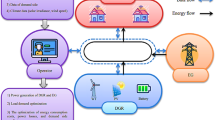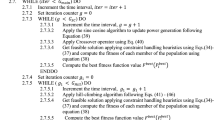Abstract
The combined economic and emission dispatch (CEED) problem where objective function is highly non linear, non-differentiable and may have multiple local minima. Therefore, classical optimization methods may not converge or get trapped to any local minima. This paper proposes a Hybrid Big Bang–Big Crunch (HBB–BC) optimization algorithm technique for solving the CEED. Six generator test and IEEE 30 standard bus system was used for testing and validation purposes. The preference of the HBB–BC is compared with other heuristic methods. The results show, clearly, that the proposed method gives better optimal solution as compared to the other methods.







Similar content being viewed by others
References
Abido MA (2003) A niched Pareto genetic algorithm for multiobjective environmental/economic dispatch. Electr Power Syst Res 25:97–99
Abido MA (2006) Multiobjective evolutionary algorithms for electric power dispatch problem. IEEE Trans Evol Comput 10:315–329
Cai J, Xiaoqian M, Qiong L, Lixiang L, Haipeng Peng D (2009) A multi-objective chaotic particle swarm optimization for environmental/economic dispatch. Energy Convers Manage 50:1318–1325
Charles VC, Huq F (2013) CO2 and cost optimization of reinforced concrete frames using a Big Bang–Big Crunch algorithm. Eng Struct 48:363–372
Chen P-H, Chang H-C (1995) Large-scale economic dispatch by genetic algorithm. IEEE Trans Power Syst 10:19–26
El-Keib A, Ma H, Hart JL (1994) Economic dispatch in view of the clean air act of 1990. IEEE Trans Power Syst 9:972–978
Erol OK, Eksin I (2006) New optimization method: Big Bang–Big Crunch. Adv Eng Softw 37:106–111
Farag A, Al-Baiyat S, Cheng TC (1995) Economic load dispatch multiobjective optimization procedures using linear programming techniques. IEEE Trans Power Syst 10:731–738
Giang Z-L (2003) Particle swarm optimization to solving the economic dispatch considering the generator constraints. IEEE Trans Power Syst 18:1187–2123
Granelli GP, Montagna M, Pasini GL, Marannino P (1992) Emission constrained dynamic dispatch. Electric Power Syst Res 24:56–64
Helsin JS, Hobbs BF (1989) Amultiobjective production costingmodel for analyzing emission dispatching and fuel switching. IEEE Trans Power Syst 4:836–842
Jiejin C, Xiaoqian M, Lixiang L, Peng PH (2007) Chaotic particle swarm optimization for economic dispatch considering the generator constraints. Energy Convers Manage 48:645–653
Kaveh A, Talatahari S (2010) A discrete Big Bang–Big Crunch algorithm for optimal design of skeletal structure. Asian J Civ Eng 11(1):103–122
Kaveh A, Zolghadr A (2012) Truss optimization with natural frequency constraints using a hybridized CSS-BBBC algorithm with trap recognition capability. Comput Struct 102–103:14–27
Kaveh A, Talatahari S (2009) Size optimization of space trusses using Big Bang–Big Crunch algorithm. Comput Struct 87:1129–1140
Khamsawang S, Jiriwibhakorn S (2009) Solving the economic dispatch problem using novel particle swarm optimization. Int J Electric Electron Eng 3:41–46
Labbi Y, Ben Attous D (2010) Big Bang–Big Crunch optimization algorithm for economic dispatch with valve-point effect. J Theor Appl Inf Technol 6:48–56
Ongsakul W, Dechanupapritttha S, Ngamroo I (2001) Tabu search algorithm for constrained economic dispatch. In: Proceedings of the international conference on power systems, Wuhan, China, p 428–433
Ongsakul W, Dechanupapritttha S, Ngamroo I (2004) Parallel tabu search algorithm for constrained economic dispatch. IEE Proc 151(2):157–166
Panigrah BK, Yadav SR, Agrawal S, Tiwari MK (2006) A clonal algorithm to solve economic load dispatch. Electric Power Syst Res 77:1381–1389
Pothiya S, Ngamroo I, Kongprawechnon W (2007) Application of multiple tabu search algorithm to solve dynamic economic dispatch considering generator constraints. Energy Convers Manage 49:506–516
Pothiya S, Ngamroo I, Kongprawechnon W (2008) Application of multiple tabu search algorithm to solve dynamic economic dispatch considering generator constraints. Energy Convers Manage 49:506–516
Roa-Sepulveda CA (1996) Environmental economic dispatch via hopfield neural network and Taboo search. In: UPEC’96 universities power engineering conference, Crete, Greece, p 1001–1004
Talaq JH, El-Hawary F, El-Hawary ME (1994) A summary of environmental/economic dispatch algorithms. IEEE Trans Power Syst 9:1508–1516
Walters DC, Sheble GB (1993) Genetic algorithm solution of economic dispatch with valve point loading. IEEE Trans Power Syst 99:1325–1332
Wang KP, Fung CC (1993) Simulate annealing base economic dispatch algorithm. IEE Proc C 140(6):507–513
Wood AJ, Wollenberg BF (1984) Power generation, operation and control. Wiley, New York
Yang HT, Yang PC, Huang CL (1996) Evolution programming based economic dispatch for units with non-smooth fuel cost functions. IEEE Trans Power Syst 11(1):112–118
Yokoyama R, Bae SH, Morita T, Sasaki H (1988) Multiobjective generation dispatch based on probability security criteria. IEEE Trans Power Syst 3:317–324
Author information
Authors and Affiliations
Corresponding author
Appendix
Appendix
Generalized loss coefficient for IEEE-30 bus test system:
Rights and permissions
About this article
Cite this article
Labbi, Y., Ben Attous, D. Environmental/economic power dispatch using a Hybrid Big Bang–Big Crunch optimization algorithm. Int J Syst Assur Eng Manag 5, 602–610 (2014). https://doi.org/10.1007/s13198-013-0210-5
Received:
Published:
Issue Date:
DOI: https://doi.org/10.1007/s13198-013-0210-5




